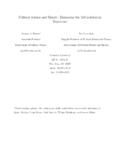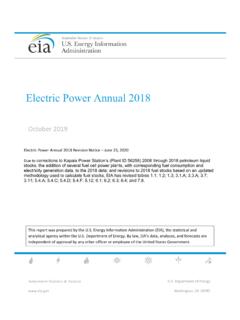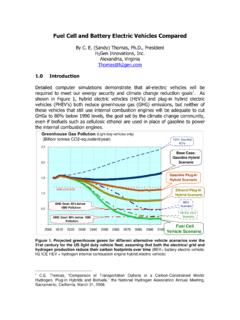Transcription of Electric Bus Analysis for New York City Transit
1 Electric Bus Analysis for New York City Transit Image by AEMoreira042281. By Judah Aber Columbia University May 2016. Background New York City Transit has requested an Analysis comparing the current fleet of buses to Electric buses. The current fleet of buses consists primarily of diesel and hybrid diesel buses, plus some CNG buses. The Analysis will center on the economics (financials) of the Electric bus alternative as well as on the environmental considerations (greenhouse gas emissions and air pollution). In addition, there will be consideration of potential implementation requirements, issues and recommendations.
2 ABSTRACT. NYC Transit and MTA bus have a combined fleet of about 5,700 buses for public transportation in New York City. The fleet currently consists of a mix of diesel, hybrid diesel and CNG. (compressed natural gas) buses. Electric buses have vastly lower greenhouse gas (GHG) emissions than the current fleet. Changing the entire fleet of buses to Electric buses would result in a reduction of emissions within the city of approximately 575,000 metric tons of CO2e per year. The net savings, including the incremental power generation required for the Electric buses is nearly 500,000 metric tons of CO2e assuming the current mix of power generation in New York City and Westchester (EPA).
3 From a financial perspective, the savings associated with fuel (cost of diesel vs. cost of electricity) and with bus maintenance more than offsets the higher cost of Electric buses including the cost of the recharging infrastructure over the lifetime of a bus. Typically, Electric buses cost about $300k more than diesel buses, and annual savings are estimated at $39k per year over the 12-year lifetime of the bus, excluding health care cost benefits. Switching to Electric buses eliminates the air pollution caused by diesel bus fuel combustion. The resulting health benefit to the populous of the city from the reduction of respiratory and other diseases is estimated at $150k per bus based on EPA data.
4 When applied to the financial case, the $150k improvement makes the case more compelling, and the health benefits should be a key consideration in the decision to switch to the new technology. The MTA will have challenges associated with a changeover to Electric buses, but effective planning can make the change nearly invisible to customers. The recommendation of this Analysis is that New York City should begin taking steps to convert the bus fleet to all Electric . 2. TABLE OF CONTENTS. Executive 5. Approach / 7. Data Collection / Assumptions .. 8. 8. Quantity of Buses .. 8. Age of the Buses and Fuel Economy/Efficiency (mpg).
5 9. Distance Traveled by the Buses .. 10. Environmental 10. Greenhouse Gas Analysis .. 11. Results of the GHG Analysis of the Existing Fleet of Buses .. 11. Comparing GHG Emissions of the Existing Fleet with Known Actuals .. 11. Greenhouse Gas Analysis for Electric Buses .. 12. GHG Comparison Between Existing Fleet and Electric Buses .. 12. Financial Analysis .. 14. Fuel 14. Electricity Cost .. 15. Maintenance Cost .. 16. Lifetime Cost .. 16. Payback Period and Net Present Value (NPV) .. 16. Sensitivity Analysis .. 17. Health Benefits, Healthcare Costs and the Cost of Greenhouse Gases.
6 18. Financial Analysis Summary .. 20. Implementation Requirements .. 21. Bus Vendors, Batteries, Range and Efficiency .. 22. BYD .. 22. Proterra .. 22. Other Electric Bus 22. Batteries .. 23. 3. Experience in Other Cities .. 24. Foothill Transit , Greater Los Angeles, California .. 24. Antelope Valley Transit Authority, Northern Los Angeles, California .. 24. Vienna, Austria .. 24. Chicago, Illinois .. 25. London, England .. 25. University Campus Buses .. 25. Bus Financing .. 26. Results / Conclusions / Suggestions .. 27. Further Suggestions and Considerations .. 29. Appendix .. 30.
7 Bibliography .. 33. 4. EXECUTIVE SUMMARY. New York City Transit has requested an Analysis considering changing from the current fleet of buses to Electric buses. NYC Transit and MTA bus have a combined fleet of about 5,700 buses for public transportation in New York City. The fleet includes diesel, hybrid diesel, and CNG. (compressed natural gas) buses. Greenhouse gases emissions from transportation contribute to global climate change, and Electric buses have much lower greenhouse gas emissions than diesel, hybrid diesel, or CNG buses. Changing the entire fleet to all Electric buses would result in a reduction of emissions within the city limits of approximately 575,000 metric tons of CO2e per year.
8 The net savings, including the incremental power generation required for the Electric buses is a reduction of nearly 500,000 metric tons of CO2e assuming the current mix of power generation in New York City and Westchester County (EPA). Consideration was also given to the possibility of a change in the power generation sources. Assuming a power mix that has the highest level of greenhouse gases in the country, the EPA region designated as The Rockies, the worst case savings would still be about 300,000. metric tons of CO2e per year. There are some variations possible based on bus manufacturer, bus routes, number of passengers and seasonal impacts to battery life.
9 However, the overall and net results will not change appreciably on an average annual basis. The financial Analysis of Electric buses vs. the existing fleet of buses looks at the difference in the cost of a new Electric bus vs. a diesel bus, and the cost of overall operations including fuel and maintenance costs. The cost of a diesel bus can range from roughly $450K to $750K depending on the characteristics of the bus. Smaller buses, 35 and 40 foot, typically sit at the lower end of the cost spectrum while 60 foot articulated buses have prices at the high end of the range. Electric buses cost about $300K more including the cost of the infrastructure.
10 From a net financial perspective, the $39K annual savings associated with fuel (cost of diesel or CNG vs. cost of electricity) and bus maintenance more than offsets the higher cost of Electric buses over the 12- year lifetime of the bus, excluding health care cost benefits. A sensitivity Analysis was performed showing alternative differences in bus cost and in operating costs. Health benefits and associated reductions in health care costs are important byproducts of a switch from diesel buses to all Electric buses. The EPA created a Diesel Emissions Quantifier tool that includes a health benefit Analysis component.













